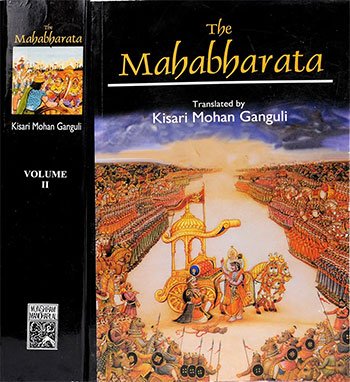Section IX - Varsha of Bharata: Kuru-Pancalas, Rivers, Tribes and Kingdoms
Book index: Mahabharata (English)
This page contains a summary of the Mahabharata Section IX including examples of moral lessons in daily life. The Maha-Bharata is one of the largest epics ever written containing roughly 100,000 Sanskrit verses. It deals with the legendary history of ancient India and contains a large number of interwoven tales.
Short summary of the chapter:
Dhritarashtra seeks information about the land of Bharata, which is coveted by his son Duryodhana and the sons of Pandu. Sanjaya describes Bharata as a land beloved by many ancient kings and gods, rich in rivers and mountains. He lists numerous rivers and mountains within Bharata, with diverse peoples and tribes inhabiting the land. Sanjaya then details the various provinces and kingdoms within Bharata, including those in the north, south, and east, inhabited by different tribes and communities.
The land of Bharata is described as a land of immense wealth and prosperity, coveted by many kings and rulers. Its resources, if properly utilized, can provide abundance in virtue, profit, and pleasure. Sanjaya emphasizes that Earth is a precious refuge for all beings, whether celestial or human, and kings are willing to go to great lengths, including battle, to possess it. The Kurus and Pandavas are engaged in a fierce struggle for control of Earth, using various means such as negotiation and gift-giving.
The ambition of kings for power and wealth is portrayed as insatiable, akin to dogs fighting over meat. The desire to rule over Earth drives them to engage in conflict and competition, disregarding the consequences. Sanjaya emphasizes the importance of stewardship and proper care of Earth, as it holds the role of a nurturing mother and provider for all beings. The land of Bharata is depicted as a sacred and bountiful land, with the potential to support and sustain all living creatures.
The story highlights the interconnectedness of all beings with the land and the natural world, underscoring the importance of responsible stewardship and harmony with nature. The struggle for power and control over Earth is shown to be driven by greed and ambition, leading to conflicts and divisions among kings and kingdoms. Despite the chaos and competition, the beauty and abundance of Bharata's land stand out as a reminder of the essential role of nature in sustaining life. The tale serves as a cautionary reminder of the consequences of unchecked ambition and the importance of respecting and protecting the Earth for the well-being of all.
Full English translation:
This page is merely a summary which is automatically generated. If you are looking for authentic sources such as the Sanskrit text or the Full English translation of Mahabharata Section IX - Varsha of Bharata: Kuru-Pancalas, Rivers, Tribes and Kingdoms, have a look at the following articles:
Section IX, online text
English translation by Kisari Mohan Ganguli.
Read this and other chapters online.
Mahabharata (English Summary)
by Kisari Mohan Ganguli | ISBN-10: 8121505933
Buy the latest edition:
FAQ of Mahabharata, Section IX:
What are the different tribes and kingdoms mentioned in the story?
The story lists various tribes and kingdoms including the Kuru-Pancalas, Dravidas, and Mlecchas among others, showcasing the diverse population of Bharatvarsha.
Why are the kings covetous of Earth in the story?
The kings desire Earth for its wealth and resources, viewing it as a source of power and prosperity that they are willing to fight for and even sacrifice their lives.
What is the significance of Earth according to the narrative?
Earth is depicted as a valuable asset that offers virtues, profits, and pleasures, symbolizing abundance and prosperity when properly utilized and protected by brave and virtuous rulers.
How are the tribes and kingdoms described in the story interconnected?
The narrative highlights the interconnectedness of various tribes and kingdoms through their shared ambitions, struggles, and desires for possession of Earth, showcasing the complex relationships and power dynamics in Bharatvarsha.
Daily life: Varsha of Bharata: Kuru-Pancalas, Rivers, Tribes and Kingdoms:
The story highlighted involves a conversation between Dhritarashtra and Sanjaya, discussing the covetous nature of kings towards Earth, driven by the desire to possess and enjoy its resources. This narrative serves as a metaphor for the ceaseless human pursuit of wealth and control, often leading to conflicts and unhappiness. It suggests that just like kings, individuals today might also find themselves locked in a constant struggle to acquire more, driven by an insatiable hunger for material gains, which can lead to a cycle of competition and dissatisfaction akin to the dogs fighting over meat mentioned in the story.
In applying this to daily life, the takeaway is the importance of stewarding resources wisely and recognizing the value of contentment and sustainable living. Earth's bounty, when managed well, can provide for our needs—offering security, sustenance, and joy. However, unchecked ambition and a relentless pursuit of acquisition can blind us to what truly matters, such as relationships, personal growth, and contributing positively to the community.
The story encourages a shift in perspective: from coveting more to nurturing gratitude for what we have and safeguarding the environment and resources for future generations. It reminds us to live consciously, making choices that align with the well-being of our planet and fellow beings, rather than yielding to the short-sighted temptations of greed and competition. Through mindful living, we can find greater fulfillment and peace, developing a harmonious relationship with Earth that is based on respect and sustainability rather than exploitation and conflict.
